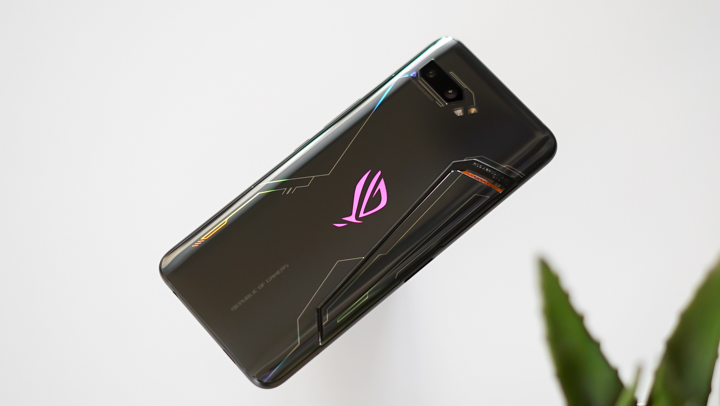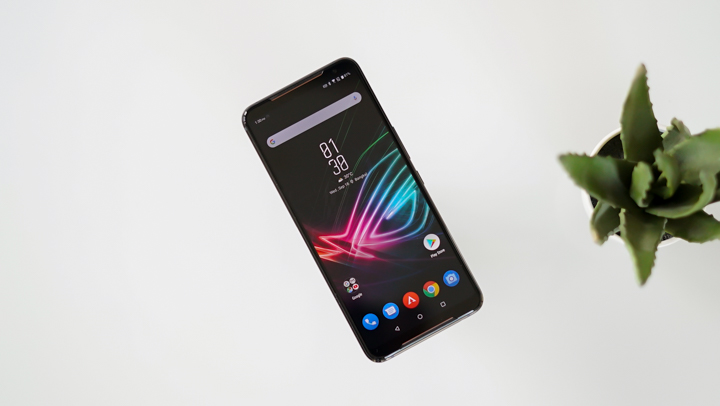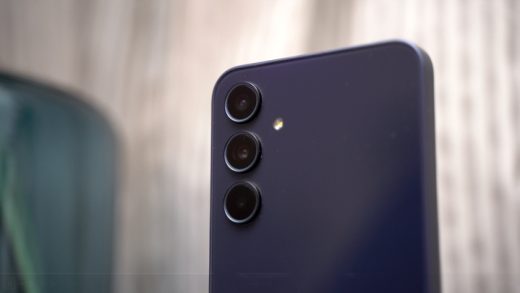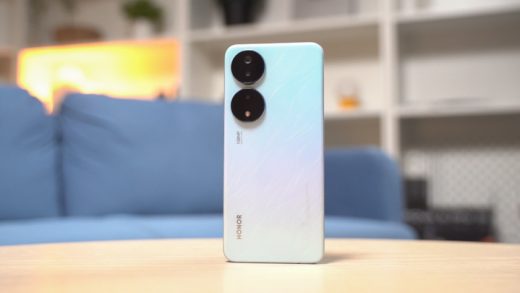It’s been a year since ASUS ROG unveiled its first gaming smartphone, the ROG Phone. It catered to users who want to have the best hardware and experience when it comes to mobile gaming. Then in 2019, they unveiled its successor, the ROG Phone II, with better specs, more features, and a meaner look. Check out our full review below.

Table of Contents
Design and Construction
The ROG Phone II retains the appeal of its predecessor but with some design changes. One of the things you’ll notice is the thinner top and bottom bezel. It doesn’t have the full-screen or notched screen design of some smartphones, but it’s not a downer as it still looks good.

You’ll also notice that the stereo speakers are different from the original ROG Phone. The orange accent is still there but is now linear and more subtle. I prefer this actually as it emphasizes the reduced bezels. The screen is now larger at 6.59-inches with Corning Gorilla Glass 6 and has the 24MP front camera housed above it.

On the left, is the USB-C port for the ROG Phone II accessories as well for ROG’s HyperCharge, then towards the bottom is the dual nano-SIM card tray.

On the right, we have the volume rocker and power/lock buttons. They’re solid and clicky, and easy to reach despite the tall build since it’s placed near the middle of the frame. Also found here are the microphone and the AirTrigger II which features new algorithms, upgraded 20ms vibration latency, and support for sliding touch gestures.

Up top, we have the secondary microphone, while down at the bottom are the USB Type-C port for HyperCharge as well, 3.5mm audio port, and two more microphones (for a total of four).

At the back, the ROG Phone II sports a familiar yet improved design. The triangular ROG Aerodynamic System now looks like it’s part of the whole device unlike the one on the original ROG Phone which looks awkward.

The camera placement was retained and now houses a 48MP + 13MP dual rear cameras with dual-LED flash. The RGB-illuminated ROG logo is still here but is now accented with lines that reflect rainbow colors depending on how the light hits it. You’ll notice that it no longer has a fingerprint scanner at the back as it now uses an in-display fingerprint scanner. It makes the device look more seamless and emphasizes effects.

Given the upgrades, the ROG Phone II is taller, wider, thicker, and heavier than the original, but feels more premium. I’m also worried that I might drop this thing that’s why I’m glad that it comes with a protective case in the package. It’s still better than having nothing.
Display and Multimedia
ROG went all out with the ROG Phone II’s display. As mentioned earlier, the screen is larger at 6.59-inches and has slightly increased the resolution to 2340 x 1080, which equates to 391ppi. It supports HDR10 and still uses an AMOLED panel, so you’re getting punchy colors with deep blacks, as well as support for Dark Mode. It even boasts a Delta-E value of less than 1, meaning it can produce accurate colors in Standard mode.

Perhaps the most significant change here is the refresh rate. While the original ROG Phone has 60Hz, the ROG Phone II can go up to 120Hz. The result is some smooth and fluid viewing experience which is evident when navigating the UI and in gaming as well. There’s an option to adjust the refresh rate to 60Hz or 90Hz inside settings, but the 120Hz is so good in the eyes that lowering it ruins the viewing experience. The only advantage I see in lowering the refresh rate is you save some of that precious battery life.

In addition to the 120Hz refresh rate, the ROG Phone II also boasts a 240Hz touch sampling rate which results in an impressive 49ms touch latency. ROG says that it’s 44% faster than most smartphones. What this means is that the phone’s screen reacts almost instantaneously to your touches which is a significant factor when it comes to competitive mobile gaming.
As for audio, you’re getting front-firing stereo speakers. The experience is incredible as it is loud with good quality with some bass in there. It also features DTS: X Ultra, which ROG says, is for theater-quality surround sound. And the experience is just like that. It’s immersive and sounds excellent for watching videos or playing games. And although it has great speakers, the ROG Phone II retains the 3.5mm audio port so you can connect those gaming headsets.
Camera
Although built for gaming, the ROG Phone II hasn’t forgotten about photography. Gamers still need to take pictures. In this case, it has a dual-rear camera setup consisting of a 48MP F1.79 Sony IMX586 primary and a 13MP 125-degree ultra-wide secondary. It doesn’t have a fancy triple or quad-camera setups like other phones, but the configuration is enough for most daily photography needs.

Image quality is good, especially when there’s plenty of light. There’s plenty of details while colors are accurate. Even during gloomy conditions, the photos have a high dynamic range. I can’t say the same thing for the wide-angle camera as shots appear dimmer and have fewer details and dull colors. But it’s useful for group shots. Just make sure there’s a lot of light.
Low-light performance is also unimpressive. The noise quickly creeps in but Night mode can eliminate most of the noise and illuminate the subject a bit. For selfies, the 24MP produces decent photos in bright conditions. It’s not that good but not bad, either. In low-light, the images look washed out and muddy.
For videos, the ROG Phone II can record at up to 4K resolution at 60fps. It has plenty of details, but it could use some boost in dynamic range and colors. The EIS is excellent, though, as the footage is smooth even at maximum frame rate. Watch the sample below.
OS, UI, and Apps
Running the operating system is the ROG UI based on Android 9 Pie. It feels like a stock Android interface but with extra features and custom wallpapers. I like it as we get that vanilla Android experience while maintaining that gaming vibe.


Don’t let that stock experience fool you as it has plenty of features under the hood. It features the new ROG Armoury Crate which is like the control center for your gaming needs. From here, you can browse and run all your installed games, manage auto-launch game profiles, and configure your phone’s game-related settings.

It has Game Genie which automatically runs when you launch a game. It makes sure you’re getting the best gaming experience possible by optimizing the phone’s performance. It turns off notifications and messages, locks the brightness, displays game and device info.

Squeeze force is still here, which works with the help of the AirTriggers. Like in the original ROG Phone, you can squeeze the phone to launch specific apps or features like X Mode, flashlight, or Google Assistant. It’s also customizable and can be triggered either by a short or long squeeze.

It has Mobile Manager, which is a maintenance tool that cleans the memory and checks for security issues. There’s Twin Apps that duplicate apps. Safeguard which lets you send SOS messages in emergencies. OptiFlex which accelerates app launches and reduces app reloads and saves power on standby. And System Lighting which lets you customize the RGB lighting of the ROG Phone II.
Performance and Benchmarks
Powering the ROG Phone II is Qualcomm’s most powerful mobile chipset to-date, the Snapdragon 855+ with an Adreno 640 GPU and coupled to 12GB of RAM and 512GB UFS 3.0. We don’t have to tell you guys if it can run games, because it definitely can. You name it, PUBG Mobile, Mobile Legends, Asphalt 9, or Honkai Impact 3, it can run such games at max settings.

What’s going to separate this phone from other flagship devices is at how well it can handle the raw performance. This brings us to the GameCool II cooling system, which is a newly designed 3D vapor chamber. ASUS says it is more effective in removing heat from the phone during full-speed operation.

The AeroActive Cooler gets an upgrade as well and is now called the AeroActive Cooler II. It has redesigned fan blades that are quieter and can provide more airflow into the ROG Aerodynamic System.
What these features are saying is that the ROG Phone II has improved thermal management for better performance. To give us an idea, we measured the temperature of the ROG Phone II in different scenarios. When idle, the ROG Phone II has a surface temp of 33.3°C. We played PUBG Mobile for an hour, and the temperature jumped to 36.6°C, which is warm but not unusual. And then we used the AeroActive Cooler II, and it was able to lower the temperature to 31.3°C. That’s impressive!
As for X Mode, it’s a feature that you’d want to activate before playing a game. When enabled, it dedicates the ROG Phone II’s system performance to gaming apps by bumping the CPU clocks, and by eliminating RAM-eating and battery-sapping app activity. It also affects benchmark scores too, as you can see below.
| Benchmarks | X Mode off | X Mode on |
|---|---|---|
| AnTuTu | 487,124 | 497,291 |
| 3DMark SSE | 6,196 (OpenGL ES 3.1) | 6,200 (OpenGL ES 3.1) |
| 5,444 (Vulkan) | 5,430 (Vulkan) | |
| PCMark (Work 2.0) | 10,357 | 13,620 |
| Geekbench | 767 (Single-Core) | 770 (Single-Core) |
| 2,840 (Multi-Core) | 2,831 (Multi-Core) | |
| 2,529 (OpenCL) | 2,776 (OpenCL) | |
| AndroBench | 1,418.75 MB/s (Seq. Read) | 1,432.57 MB/s (Seq. Read) |
| 395.91 MB/s (Seq. Write) | 396.67 MB/s (Seq. Write) |
As for gaming performance, we used GameBench to measure frame-rates when running our favorite games and compared it to the performance of the ROG Phone. As expected, it performed better, hitting 60fps in games like Asphalt 9, PUBG Mobile, and Mobile Legends.

Accessories

Just like the initial ROG Phone, the sequel comes with its very own carry-on luggage filled with a bunch of accessories.

First, we have the WiGig Display Dock. –It’s basically a Google chrome cast on steroids; Users can hook the dock up to a bigger display, like a television or even a projector. Once it’s correctly set-up, users will be able to cast and play their favorite mobile games to the big screen super smooth, and latency-free.

Next is the ROG Mobile Desktop Dock. This dock, as the name suggests, turns the ROG Phone II into a mobile desktop. For I/O, starting with the inputs we get – DisplayPort 1.3, USB 3.0 Micro-B, an SD Card slot, 4 x USB 3.1 Gen1 Type-A, 3.5mm microphone, RJ45 Gigabit LAN, and a Type-C port to power up the dock. For outputs, we have HDMI 2.0, DisplayPort 1.3 and a 3.5mm combo jack. The mobile desktop dock’s build quality is superb! What we didn’t like was the exclusion of the USB 3.0 Micro-B cable (one of the most annoying wires in the world, used for external HDDs). Users checking out this dock are probably thinking of pairing up a mouse and keyboard to their beastly mobile gaming device, and it does work seamlessly.

Third, we have the TwinView Dock II. So yes, like the ROG Phone II itself, this is the second iteration of the TwinView Dock accessory from ASUS. The first-gen dock had a more compact form-factor, with two additional triggers users could program for gaming. This iteration is larger, obviously because the ROG Phone II has a larger display, but we also lose the trigger buttons.

Luckily this was by design because you can pair the TwinView Dock II with the ROG Kunai Gamepad. This accessory gives the ROG Phone II controller-functionality with 16 mappable keys.

Its design is very reminiscent of the Nintendo Switch, as the left and right ASUS “joy-cons” can be removed and paired together with a grip that’s included in the box.


Lastly, we have the Lighting Armor Case. It’s a very gamer-esque plastic case with a trick up its sleeve! Inside the case is an NFC chip, so the moment it’s slapped on, users will be greeted with an exclusive new theme that reacts when turning on X Mode. The back of the case also lights-up with the help of that RGB LED found under the actual flash.
Connectivity and Battery Life
Gaming performance does not solely depend on the phone’s chipset, graphics, or memory. Good connectivity is also essential considering that competitive games like PUBG Mobile and Mobile Legends require the internet. The ROG Phone II doesn’t disappoint in this regard. For starters, it has a WiFi design consisting of four antennas optimally located so that you’re getting the best WiFi signal even when gaming in landscape mode. Also, there’s 4G LTE Cat18, Bluetooth 5.0 with support for Qualcomm aptX Adaptive, NFC, and multiple SatNavs.

For the battery, ASUS equipped the ROG Phone II with a 6,000mAh tank. That’s massive! For comparison, the original ROG Phone only has a 4,000mAh. However, I don’t think it’s overkill though as the ROG Phone II has to keep up with the new features and more powerful hardware.
PC Mark’s battery benchmark got us 13 hours and 29 minutes which is decent. Our video loop test got us a good 22 hours and 4 minutes of playback. As for real-world use which includes lots of gaming with 120Hz on all the time, we can easily get two days of battery life.

It also has some battery saving functions to make sure that it can last longer than most phones. There’s the Adaptive Battery feature that limits battery for infrequently used apps. The battery-saving options, on the other hand, detects battery-draining apps, or deny certain apps from auto-starting. There’s Battery care as well that dynamically adjusts the charging rate to fully charge the battery to 100% during a scheduled period.
Speaking of charging, the ROG Phone II features a 30W HyperCharge that can charge the battery in just over an hour, which is impressive considering the large capacity. It also supports Quick Charge 4.0 and PD charging when you don’t have the power brick with you.
Conclusion
There are different kinds of flagship smartphones. There are those designed for productivity, some for photography, while others are all-rounders. Then we have the gaming types. The ROG Phone II, just like its predecessor, falls in this category.

ASUS has outdone themselves this time. The ROG Phone II is way better than its predecessor in almost every aspect and can deliver its promise to provide the best mobile gaming experience possible by injecting new features and accessories. The only question left to answer is the price. The ROG Phone II is priced at PHP 49,995 (12GB + 512GB), which is the original ROG Phone when it launched. It’s still pricey, but hey, you get what you pay for. If money is no object and you want the best gaming phone out there, the ROG Phone II will satisfy your needs.
ASUS ROG Phone II specs:
6.59-inch FHD+ (2340 x 1080) 19.5:9 AMOLED display
HDR support
120Hz refresh rate, 1 ms response time
Corning Gorilla Glass 6
Qualcomm Snapdragon 855+ 2.96GHz octa-core
Adreno 640 GPU
12GB RAM
512GB storage
48MP F1.79 IMX586 + 13MP 125-degree ultra-wide dual rear camera
24MP front camera
4G LTE Cat 18
Bluetooth V 5.0 (BR/EDR+LE), supports Qualcomm aptX Adaptive
Wi-Fi 802.11 a/b/g/n/ac (2×2 MIMO)
NFC
GPS (L1+L5), GLO, BDS, GAL (E1+E5a), QZSS (L1+L5)
3x USB Type-C ports (bottom, sides)
AirTriggers 2.0
Front-facing stereo speakers
ARCore support
3.5mm audio port
In-display fingerprint scanner
Face Unlock
ROG UI/ZENUI (Android 9 Pie)
6,000mAh battery w/ 30W ROG HyperCharge technology, Qualcomm QuickCharge 4.0
170.99 x 77.6 x 9.48 mm
240 g
What we liked:
• Premium build
• Attractive design
• Great display
• Great performance
• Long battery life
• Gaming accessories
• Good quality speakers
• HyperCharge!
What we didn’t:
• Unimpressive wide-angle and front camera quality

























pwede po ba hulugan ang rog phone 2? kung pwede po magkano po 1st payment and magkano po siya buwan buwan? and ilang buwan po thanks po